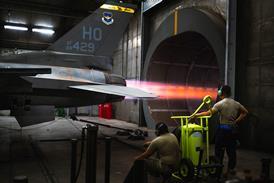Ramon Lopez/WASHINGTON DC
General Atomics Aeronautical Systems has concluded the first phase of testing for a UK project aimed at seeing whether high-altitude, long endurance unmanned air vehicles can replace military communications satellites in relaying critical data between aircraft.
The UK Defence Evaluation and Research Agency (DERA) Project Extendor envisages using UAVs such as the General Atomics Predator B as a relay platform for the Joint Tactical Information Distribution System (JTIDS) being fitted to a number of Royal Air Force tactical and support aircraft, allowing them to share data during an air campaign.
The JTIDS data link is line-of-sight, however, and needs either a spacecraft or the much cheaper UAV to serve as a data and image relay station.
The test was conducted at the firm's El Mirage, California, flight operations facility using a General Atomics RQ-1 Predator medium-altitude endurance UAV. It had been hoped to use the more capable Predator B, but it was not ready in time.
DERA's evaluations used a Predator to pass real-time operational data from a ground-based forward air controller to an RAF Jaguar aircraft. Also involved in the two-week flight trial were the US Navy and US Air Force's UAV Battlelab at Eglin AFB, Florida, which trialled a Grumman F-14 and Lockheed Martin F-16 to further test the "sensor-to-shooter" concept.
Three scenarios were conducted using Rockwell Collins ARC-210 radios to move imagery and text messages between the Predator and a ground control station (GCS). In the first scenario, the FAC identified a target and relayed information to the Jaguar via Predator. The second scenario added Low Altitude Navigation and Targeting Infrared for Night and Fast Tactical Imagery images to the strike aircraft.
The third scenario went one step further. In this case, the Predator captured video imagery of the target and passed it to the GCS, which selected three screenshots, annotated with a target triangle, north indication arrow and target co-ordinates. This information was then sent back through the UAV to the attack aircraft.
Phase 2 of Project Extendor, to be conducted in September, will introduce an improved data modem. The third and final phase, which gets under way a year later, will add JTIDS to the flight trials.
The Battlelab has previously demonstrated the surrogate satellite concept, and the data was informally shared with the UK.
Source: Flight International























